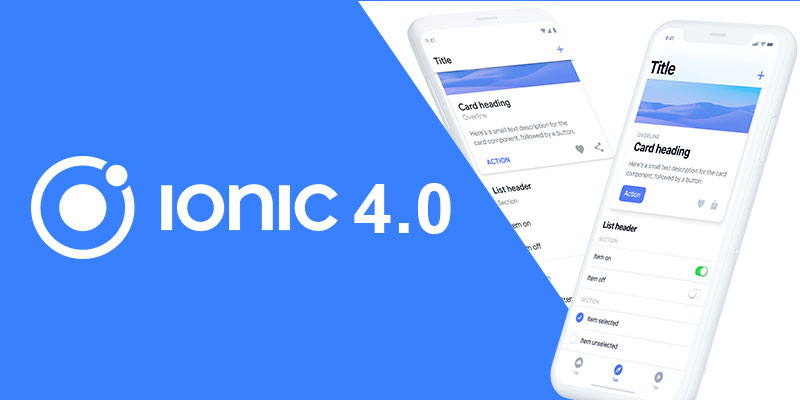
Ionic is the most popular platform for the creation of both mobile apps and desktop apps. The platform has grown over time to include many updates, and the Ionic Framework 4.0 release features new options that make life better for developers and their clients. As Ionic changes, the flexibility and creativity of mobile apps or desktop apps will blossom.
Because Ionic is open source, it offers developers the chance to create a platform that they can use every day. Ionic wants to keep up with the market as it learns from its users, and that is why the Ionic 4.0 release has been eagerly anticipated by the development world.
What Does Ionic Do?
Ionic 4.0 improves upon a platform that currently allows five million developers to create an application that works for consumers and internal functions. The platform was designed to be as efficient as possible, and it uses a few core values to make it easy for everyone to use. The apps that are released out of the Ionic framework are Performance Web apps or PWA that look consistent and gorgeous on every platform where they are used.
•Ionic uses one codebase that works with all the different technologies that it could reach. This makes Ionic more flexible than other programs that hope to build apps.
•There is a UI library designed around Web Components.
•This UI library works on all platforms.
•Open web standards were used to make sure that Enterprise programs could be adaptable to all new situations.
•Ionic is scalable.
•The components are in just one library that can be accessed or shared among all the people that are working on a project.
What Is The Universal Codebase?
The universal or shared codebase makes it possible for every app to be created using the appropriate tools for the system or platform where that app will be deployed. Developers do not need to hunt for the tools they need, and they can adapt the programming for each new system where the app will run. Developers are not limited to just one operating system, and the customer will get an app that works everywhere.
The consistency that is provided through the universal or shared codebase makes these apps look nice no matter where they are viewed or used. The brand consistency makes it possible for a company to put its best foot forward. Customers do not get frustrated because of their mobile apps and/or desktop apps work faster. Enterprise workers can work more efficiently because they are using an app that works the way it is supposed to. If the company that ordered the app is offering consistency to its employees, those employees are more efficient.
What Are Open Web Standards?
Open Web Standards are used within Ionic to make sure that the developer can use those tools inside a JavaScript framework like React or Angular. Some people might not even want to use a framework, and that is why they turn to Ionic. The platform does not force the developer into a box that makes them uncomfortable (when all that needs to be added is a script tag.)
Because of this, Ionic apps are considered to be backend agnostic. That will allow the developer to link up with Firebase, Azure, or AWS without any trouble.
Why Is Ionic An Efficient Way To Build Apps?
The shared or universal codebase makes every build efficient because there is no need to hunt for the tools that are needed. Teams can easily use this program because they are all shopping in the same UI library. If you are working on a project, you know that your partners at another desk (or halfway across the world) are using the same tools you are. Yes, you can be creative, but you are not using different toolboxes to get the job done.
Ionic Helps Developers Build Anything They Want
Ionic has what is called a “complete app development kit” that includes tools for creating front-end and back-end programs. These UI parts can be pieced together to create anything the developer wants, and these technologies work with HTML, CSS, and JavaScript (and so many more.) The company’s platform offers faster response times for all modern browsers or platforms like iOS or Android, Electron or PWAs.
Fringe Benefits
Ionic allows developers to build apps that are much smaller than normal, and the Web Components catalog makes it possible to create apps that work when bandwidth is extremely low. This is one of the best things that can happy to a small company that is trying to grow. That firm cannot afford a fast Internet connection, but it can still get work done. Also, Ionic has include defaults in 4.0 that speed up response times automatically. A small app that does not take up much space will run faster, and a company that plans to an app to every desktop in its office is not worried about slowing down everyone that works there.
Here it from CEO Max Lynch himself:
“When we look at what’s happening in the world of front-end development, we see two major industry shifts….more and more enterprises are recognizing the need to adopt a design system: a single design spec, or library of reusable components, that can be shared across a team or company…rebuilding our Framework on Web Components was a way to address both of these challenges and future-proof our technology in a truly unique way.”
Final Thoughts
Ionic 4.0 has created the most powerful tools for app development. They allow developers to build enterprise apps that use devices built in the Studio development environment, AppFlow, and the mobile DevOps platform or Enterprise Engine. Every developer can narrow down the type of app they would like to build, and they pull from the UI parts that are needed for that project. In the end, every app looks perfect, works everywhere, and was easy for the team to create without confusion or creative differences.

